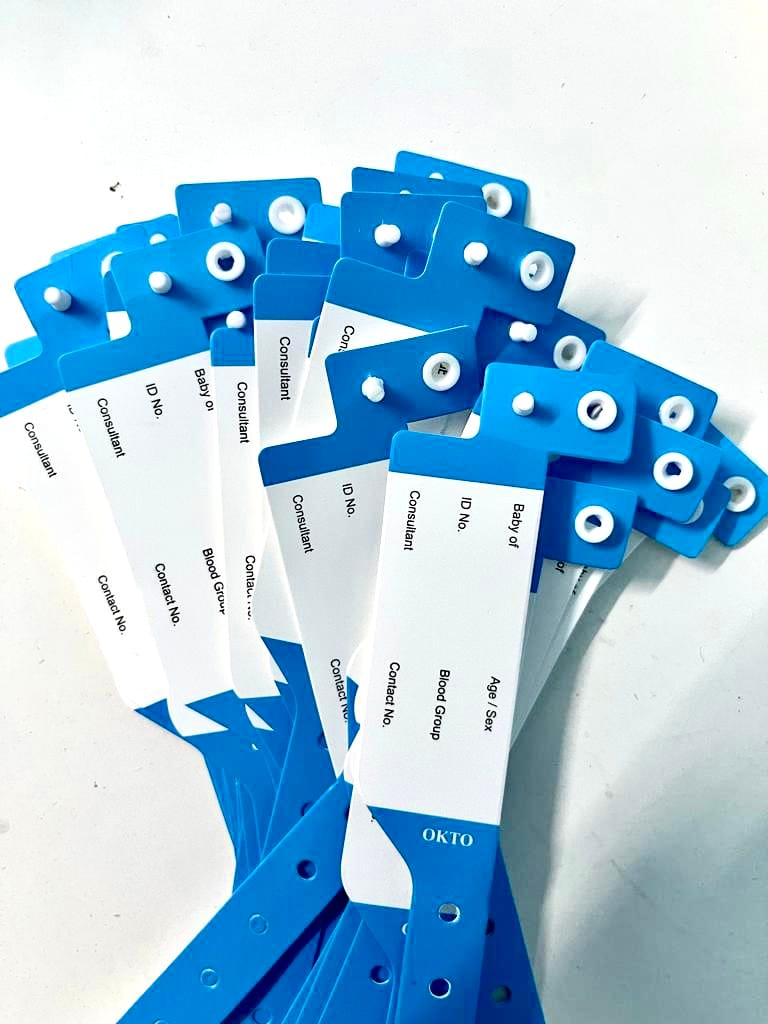Simplifying Client Treatment With Effective Recognition Bands
The application of reliable identification bands is a crucial component in enhancing individual treatment within healthcare setups. These bands not only serve to minimize the risks connected with client misidentification yet also streamline interaction amongst medical personnel, consequently cultivating a safer atmosphere. Different types of identification bands accommodate details needs, from sturdy wristbands for grownups to specialized bands for infants and vital situations. As the landscape of patient identification progresses, one have to think about the implications of these systems on general health care distribution and patient results. What innovations await in this essential location?
Value of Patient Identification
Ensuring accurate individual recognition is critical in healthcare setups, as it directly influences the safety and security and quality of treatment given. Misidentification can lead to serious mistakes, consisting of administering the incorrect medicine, doing inaccurate procedures, or miscommunicating crucial person info. Such errors not only jeopardize client safety yet can likewise lead to legal ramifications and lowered rely on health care systems.
Effective patient recognition is essential to establishing a safe and secure environment where clients get suitable and personalized treatment. It assists in the accurate documents of case histories, allergic reactions, and treatment strategies, making sure that healthcare suppliers have access to essential details whatsoever times. Durable identification procedures assist simplify communication among medical team, boosting collaboration and decreasing the risk of errors.

Kinds Of Recognition Bands
Recognition bands play an essential duty in preserving exact client documents and enhancing security within medical care settings. Different sorts of identification bands are made use of to accommodate the particular requirements and needs of different client populations.

One more kind is the ankle joint band, which is especially valuable for babies and babies, guaranteeing that recognition remains undamaged even throughout treatment procedures. Specialized bands, such as those for allergy informs or fall threat signs, offer additional layers of safety and security by drawing prompt focus to vital patient problems.
Just recently, digital identification bands have actually acquired appeal, incorporating barcodes or RFID technology that can be scanned to swiftly retrieve client information. These bands streamline operations and lessen the threat of human error during client identification procedures.
Advantages of Reliable Recognition
Effective identification of individuals via using recognition bands contributes dramatically to total client security and care top quality. By guaranteeing that each patient is accurately identified, doctor can efficiently match clinical treatments and procedures to the correct individual, lessening the danger of mistakes. This is especially important in environments with high person turnover, where the potential for misidentification is higher.
Moreover, effective identification bands boost communication among medical care groups. Clear and exact client identification fosters collaboration look at these guys and makes certain that all staff member recognize an individual's particular needs and clinical history. This interaction is necessary for providing coordinated treatment, particularly in emergency scenarios where time is important.

Inevitably, efficient recognition via using identification bands not just safeguards clients however additionally advertises a culture of safety within health care facilities (Patient Identification Band). By prioritizing exact recognition, health care companies can enhance outcomes and enhance the total individual experience
Implementing Identification Solutions
While the importance of person recognition is well identified, the application of robust recognition systems presents a complex obstacle for health care organizations. Developing effective identification systems requires a comprehensive strategy, encompassing technology, personnel training, and process assimilation.
First, organizations need to choose proper identification innovations, such as barcode scanning, RFID, or biometric systems. Patient Identification Band. These innovations should be examined based on expense, functionality, and compatibility with existing facilities. A pilot program can help recognize possible issues before major implementation
Following, comprehensive training for personnel is essential. All workers need to recognize the importance of accurate person identification and excel in making use of the selected technologies. Normal training updates and assessments can reinforce ideal practices and make sure ongoing compliance.
Furthermore, health care companies ought to create standard procedures for client recognition across all divisions, reducing disparities and improving communication. Routine audits can aid identify spaces in adherence to these procedures.

Ultimately, a reliable application of recognition systems not just boosts patient security however likewise fosters a society of liability and persistance within health care settings, making sure consistent and dependable person care.
Future Trends in Individual Identification
Improvements in innovation are set to revolutionize person recognition practices in health care setups. The combination of biometric identification techniques, such as fingerprinting and face recognition, is anticipated to improve precision and safety and security. These innovations can considerably reduce the risk of misidentification, guaranteeing that clients get the correct therapies and medications.
In addition, the implementation of blockchain modern technology for individual documents is gaining grip. This decentralized method can supply a safe and try this site tamper-proof technique for managing patient identifications, thus simplifying access to essential info across various medical care carriers.
Another pattern is the increasing usage of mobile wellness applications that leverage QR codes for person identification. These applications enable real-time updates and simple accessibility to patient data, equipping healthcare experts to make enlightened decisions promptly.
In addition, man-made knowledge (AI) is poised to play a vital role in analyzing patient identification information, recognizing patterns, and predicting prospective recognition errors prior to they occur.
As these modern technologies evolve, they promise not only to enhance person security however additionally to boost the overall performance of health care shipment systems. Accepting these technologies will certainly be critical for future-proofing patient care practices.
Final Thought
To conclude, efficient recognition bands are necessary for boosting client safety and security and care top quality within healthcare settings. By minimizing the threats connected with misidentification, these bands assist in prompt and accurate info access, ultimately boosting interaction among healthcare suppliers. The application of durable identification systems not only promotes a society of security however also positions medical care organizations to adjust to future fads in individual recognition technology, ensuring ideal results for clients in varied scientific environments.
As the landscape of individual recognition develops, one must consider the implications of these systems on total health care delivery and individual results.Effective person identification is basic to developing a safe atmosphere where patients get individualized and proper care. Eventually, focusing on efficient person identification methods not just promotes a society of safety but additionally adds to enhanced patient end results and total fulfillment with healthcare solutions.
Efficient identification of patients with the usage of identification navigate here bands adds substantially to total client safety and care quality. The implementation of durable recognition systems not just fosters a culture of safety and security however additionally placements healthcare organizations to adapt to future fads in patient recognition modern technology, ensuring optimum end results for people in diverse clinical environments.